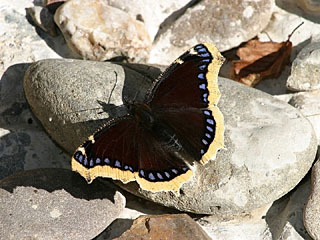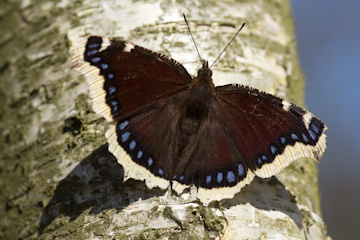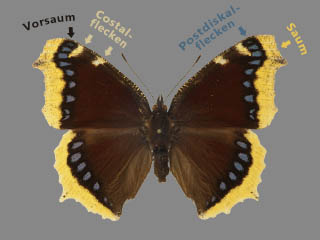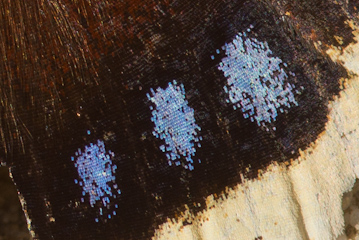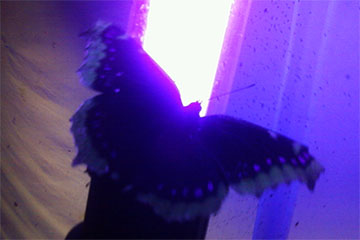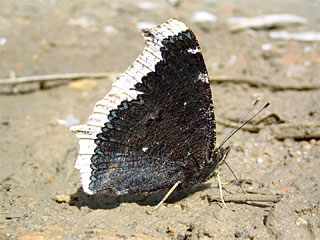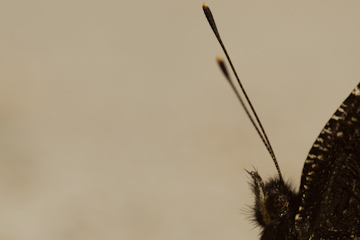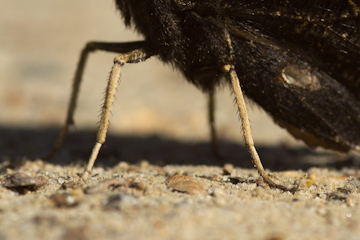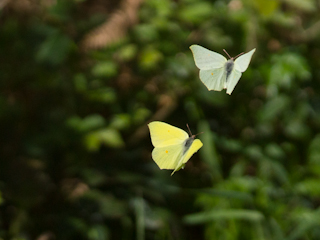 Camberwell BeautyNymphalis antiopa (Linnaeus, 1758)Mourning CloakCamberwell Beauty
Camberwell BeautyNymphalis antiopa (Linnaeus, 1758)Mourning CloakCamberwell Beauty
Camberwell Beauty (Nymphalis antiopa)
With a wingspan of up to 76 mm, the  Camberwell BeautyNymphalis antiopa (Linnaeus, 1758)Mourning CloakCamberwell Beauty is one of the largest adult butterflies found in
Camberwell BeautyNymphalis antiopa (Linnaeus, 1758)Mourning CloakCamberwell Beauty is one of the largest adult butterflies found in  Germany
Germany Germany and Europe.
Germany and Europe.
Its appearance is unique and unmistakable worldwide.
For many people, an encounter with the  Camberwell BeautyNymphalis antiopa (Linnaeus, 1758)Mourning CloakCamberwell Beauty is an extraordinary and special event.
Camberwell BeautyNymphalis antiopa (Linnaeus, 1758)Mourning CloakCamberwell Beauty is an extraordinary and special event.
Its large size and its unusual wing pattern, which is often perceived as especially beautiful, are certainly the main reasons for this.
In contrast to many other adult butterflies, the  Camberwell BeautyNymphalis antiopa (Linnaeus, 1758)Mourning CloakCamberwell Beauty hardly gives the impression of a cheerfully fluttering juggler. Instead, its appearance is often perceived as gloomy or melancholy. Some people even see the
Camberwell BeautyNymphalis antiopa (Linnaeus, 1758)Mourning CloakCamberwell Beauty hardly gives the impression of a cheerfully fluttering juggler. Instead, its appearance is often perceived as gloomy or melancholy. Some people even see the  Camberwell BeautyNymphalis antiopa (Linnaeus, 1758)Mourning CloakCamberwell Beauty as a messenger of death (see Stories/Poems (Peter Kremer: Schmetterlinge (1985))).
Camberwell BeautyNymphalis antiopa (Linnaeus, 1758)Mourning CloakCamberwell Beauty as a messenger of death (see Stories/Poems (Peter Kremer: Schmetterlinge (1985))).
 Camberwell BeautyNymphalis antiopa (Linnaeus, 1758)Mourning CloakCamberwell Beauty in d-Moll:
Camberwell BeautyNymphalis antiopa (Linnaeus, 1758)Mourning CloakCamberwell Beauty in d-Moll:

If one were to assign the  Camberwell BeautyNymphalis antiopa (Linnaeus, 1758)Mourning CloakCamberwell Beauty to a tonality, D minor would be the obvious choice.
Camberwell BeautyNymphalis antiopa (Linnaeus, 1758)Mourning CloakCamberwell Beauty to a tonality, D minor would be the obvious choice.
This tonality is characterized as lugubrious, melancholic, gloomy or gently mournful (see e.g. KölnKlavier: Tonartencharakteristik - Die Moll-Tonarten).
The  Camberwell BeautyNymphalis antiopa (Linnaeus, 1758)Mourning CloakCamberwell Beauty is also the eponym of a guitar piece composed by Boudewijn Cox (1965-)Boudewijn Cox, see: Art/Culture (Music).
Camberwell BeautyNymphalis antiopa (Linnaeus, 1758)Mourning CloakCamberwell Beauty is also the eponym of a guitar piece composed by Boudewijn Cox (1965-)Boudewijn Cox, see: Art/Culture (Music).
The upper wing surfaces of the  Camberwell BeautyNymphalis antiopa (Linnaeus, 1758)Mourning CloakCamberwell Beauty are brownish/velvety black.
Camberwell BeautyNymphalis antiopa (Linnaeus, 1758)Mourning CloakCamberwell Beauty are brownish/velvety black.
On the outer edges there is a continuous yellow border interspersed with small black dots.
 Camberwell BeautyNymphalis antiopa (Linnaeus, 1758)Mourning CloakCamberwell Beauty
Camberwell BeautyNymphalis antiopa (Linnaeus, 1758)Mourning CloakCamberwell Beauty
Sunbathing Camberwell Beauty (Nymphalis antiopa) on a Birch (Betula) trunk
The Camberwell Beauty (Nymphalis antiopa) changed its position every about 5 minutes between a gravel path and the trunks of birch trees.
The border of overwintered  Camberwell BeautyNymphalis antiopa (Linnaeus, 1758)Mourning CloakCamberwell Beauties is usually faded light yellow to whitish.
Camberwell BeautyNymphalis antiopa (Linnaeus, 1758)Mourning CloakCamberwell Beauties is usually faded light yellow to whitish.
Some  Camberwell BeautyNymphalis antiopa (Linnaeus, 1758)Mourning CloakCamberwell Beauties overwinter without losing colour and appear in spring with magnificent colours Böhling, 1996 - Eine Beobachtung zur Überwinterung des Trauermantels (Nymphalis antiopa L.) in der Lüneburger Heide. Other
Camberwell BeautyNymphalis antiopa (Linnaeus, 1758)Mourning CloakCamberwell Beauties overwinter without losing colour and appear in spring with magnificent colours Böhling, 1996 - Eine Beobachtung zur Überwinterung des Trauermantels (Nymphalis antiopa L.) in der Lüneburger Heide. Other  Camberwell BeautyNymphalis antiopa (Linnaeus, 1758)Mourning CloakCamberwell Beauties have an innate white border (especially in Scandinavia). There are also colour variations of yellow and white Esper, 1777 - Die Schmetterlinge in Abbildungen nach der NaturCockayne, 1921 - The White Border of Euvanessa antiopa L.Chalmers-Hunt, 1977 - The 1976 Invasion of the Camberwell Beauty (Nymphalis antiopa L.). There are many attempts to explain the colour of the
Camberwell BeautyNymphalis antiopa (Linnaeus, 1758)Mourning CloakCamberwell Beauties have an innate white border (especially in Scandinavia). There are also colour variations of yellow and white Esper, 1777 - Die Schmetterlinge in Abbildungen nach der NaturCockayne, 1921 - The White Border of Euvanessa antiopa L.Chalmers-Hunt, 1977 - The 1976 Invasion of the Camberwell Beauty (Nymphalis antiopa L.). There are many attempts to explain the colour of the  Camberwell BeautyNymphalis antiopa (Linnaeus, 1758)Mourning CloakCamberwell Beauty, see: Research about border-color (Outline)).
Camberwell BeautyNymphalis antiopa (Linnaeus, 1758)Mourning CloakCamberwell Beauty, see: Research about border-color (Outline)).
In Europe, there is a north/south gradient in the colour of the border: In the north, they tend to have an innate lighter hem colour. In the south, the colour tends to be more yellow.
Border, pre-border, postdiscal and costal patches of the Camberwell Beauty's (Nymphalis antiopa)
Parallel to the border is a black so-called pre-border. On this is a band of blue/purple spots. There are various names for these spots, e.g. postdiscal spots Tolman; Lewington, 1998 - Die Tagfalter Europas und Nordwestafrikas, splendour spots Bergmann, 1952 - Die Großschmetterlinge Mitteldeutschlands, antemarginal spots Rebel, 1910 - Fr. Berge's Schmetterlingsbuch nach dem gegenwärtigen Stande der Lepidopterologie or dorsal spots Standfuss, 1896 - Handbuch der paläarkitischen Gross-Schmetterlinge für Forscher und Sammler.
 Camberwell BeautyNymphalis antiopa (Linnaeus, 1758)Mourning CloakCamberwell Beauty
Camberwell BeautyNymphalis antiopa (Linnaeus, 1758)Mourning CloakCamberwell Beauty
Detail of the upper wing surface of an Camberwell Beauty's (Nymphalis antiopa)
The scales of the (here due to hibernation) light-yellow border, the black pre-border with the blue splendour spots, as well as the red-brown wing background are clearly visible.
The colour of the blue spots can change with the angle of the incident light, alternating between shades of blue and violet (source: personal observation, 22/03/2012). This is an effect similar to that of the iridescence of the male  Purple EmperorApatura iris (Linnaeus, 1758)Purple Emperor's.
Purple EmperorApatura iris (Linnaeus, 1758)Purple Emperor's.
The upper wings of the  Camberwell BeautyNymphalis antiopa (Linnaeus, 1758)Mourning CloakCamberwell Beauty usually have eight spots, the hind wings seven, which are oval or wedge-shaped.
Camberwell BeautyNymphalis antiopa (Linnaeus, 1758)Mourning CloakCamberwell Beauty usually have eight spots, the hind wings seven, which are oval or wedge-shaped.
There are two vertical white/yellowish longitudinal spots on the leading edge of the forewings, which are also called costal spots Standfuss, 1896 - Handbuch der paläarkitischen Gross-Schmetterlinge für Forscher und Sammler or wedge spots Gönner, 1928 - Der Trauermantel und sein Formenkreis.
There are a number of terms used in the literature to describe the colour of the upper wing surfaces:
black von Linné, 1767 - Caroli a Linné, Systema Naturae, Tom. I. Pars II., Editio Duodecima Reformata., dark brown-reddish De Geer, 1778 - Abhandlungen zur Geschichte der Insekten, velvety brown Seitz, 1909 - Die Gross-Schmetterlinge der Erde: Eine systematische Bearbeitung der bis jetzt bekannten Groß-Schmetterlinge, sammet brown Borkhausen, 1788 - Naturgeschichte der Europäischen Schmetterlinge, velvety black-brown, coffee brown Hofmann, 1894 - Die Großschmetterlinge Europas, chocolate brown, chocolate coloured Harris, 1766 - The Aurelian, deep reddish brown Gönner, 1928 - Der Trauermantel und sein Formenkreis, velvety dark violet-brown Bühler-Cortesi, 2009 - Schmetterlinge - Tagfalter der Schweiz, soft cherry brown Freyer, 1836 - Neuere Beiträge zur Schmetterlingskunde, Zweiter Band, Heft 25, purple-brown Scudder, 1899 - Every-day Butterflies: A Group of Biographies, dunkel rötlich-schwarz Hoffmann, 1846 - Das Buch der Welt, flea-coloured Bechstein; Scharfenberg, 1805 - Vollständige Naturgeschichte der schädlichen Forstinsekten, velvety brown-black Busch, 1956 - Interessantes aus der Insektenwelt der Hocheifel.
The basic colour of the upper side of the wings can go into black, but sometimes also into light brown Esper, 1777 - Die Schmetterlinge in Abbildungen nach der Natur. Ross LayberryRoss Layberry considers the North American subspecies  Nymphalis antiopa ssp. hyperboreaNymphalis antiopa ssp. hyperborea (Linnaeus, 1758)Nymphalis antiopa ssp. hyperborea (see: Subspecies (ssp. hyperborea)) a lighter upper wing colour tending towards brown, while the North American subspecies
Nymphalis antiopa ssp. hyperboreaNymphalis antiopa ssp. hyperborea (Linnaeus, 1758)Nymphalis antiopa ssp. hyperborea (see: Subspecies (ssp. hyperborea)) a lighter upper wing colour tending towards brown, while the North American subspecies  Nymphalis antiopa ssp. lintneriiNymphalis antiopa ssp. lintnerii (Linnaeus, 1758)Nymphalis antiopa ssp. lintnerii has a darker ground colour comparable to the European Nominiform or (new) nominotypic taxon: Taxon defined by the same name-bearing type as the higher-ranking taxon to which it itself belongs.Type Species Layberry, 2009 - Possible Subspecies of the Mourning Cloak (Nymphalis antiopa).
Nymphalis antiopa ssp. lintneriiNymphalis antiopa ssp. lintnerii (Linnaeus, 1758)Nymphalis antiopa ssp. lintnerii has a darker ground colour comparable to the European Nominiform or (new) nominotypic taxon: Taxon defined by the same name-bearing type as the higher-ranking taxon to which it itself belongs.Type Species Layberry, 2009 - Possible Subspecies of the Mourning Cloak (Nymphalis antiopa).
The border colour is also described in a variety of ways:
sulphur yellow Bühler-Cortesi, 2009 - Schmetterlinge - Tagfalter der Schweiz, straw yellow Gönner, 1928 - Der Trauermantel und sein Formenkreis, lightning yellow, buff-yellow Scudder, 1899 - Every-day Butterflies: A Group of Biographies, light yellow Harris, 1766 - The Aurelian.
There can be variations in the size, colouring and pattern of the wings. They are caused by special temperature conditions during the pupal phase (see e.g. Subspecies, Forms/Aberrations and Individual Variations).
 Camberwell BeautyNymphalis antiopa (Linnaeus, 1758)Mourning CloakCamberwell Beauty
Camberwell BeautyNymphalis antiopa (Linnaeus, 1758)Mourning CloakCamberwell Beauty
Camberwell Beauty (Nymphalis antiopa) attracted by a UV lamp
Robert Petschar was actually looking for butterflies in the Bangser Ried at the Austria/Switzerland/Liechtenstein-triangle as part of a night excursion when this Camberwell Beauty (Nymphalis antiopa) was surprisingly attracted by the UV light.
Under ultraviolet light, the colour of the  Camberwell BeautyNymphalis antiopa (Linnaeus, 1758)Mourning CloakCamberwell Beauty's appears orange with comparable intensity to normal light. In contrast to the colour of the border, the colour of the blue/purple spots does not change under ultraviolet light Phillips, 1959 - Fluorescence in the colors of certian Lepidoptera observed under ultraviolet light.
Camberwell BeautyNymphalis antiopa (Linnaeus, 1758)Mourning CloakCamberwell Beauty's appears orange with comparable intensity to normal light. In contrast to the colour of the border, the colour of the blue/purple spots does not change under ultraviolet light Phillips, 1959 - Fluorescence in the colors of certian Lepidoptera observed under ultraviolet light.
The undersides of the  Camberwell BeautyNymphalis antiopa (Linnaeus, 1758)Mourning CloakCamberwell Beauty's are black/grey/brown with similarly pale edges as the upper side of the wings.
Camberwell BeautyNymphalis antiopa (Linnaeus, 1758)Mourning CloakCamberwell Beauty's are black/grey/brown with similarly pale edges as the upper side of the wings.
 Camberwell BeautyNymphalis antiopa (Linnaeus, 1758)Mourning CloakCamberwell Beauty
Camberwell BeautyNymphalis antiopa (Linnaeus, 1758)Mourning CloakCamberwell Beauty
Camberwell Beauty (Nymphalis antiopa) sucking on soil
The underside is reminiscent of tree bark or a dried leaf.
If the adult butterfly is resting on the bark of a tree, for example, it is very well camouflaged with its wings folded together. The camouflage also reduces the probability of detection during summer resting (see: Behaviour (Aestivation)) and hibernation (see: Behaviour (Hibernation)).
Like some other Brush-footed ButterflyNymphalidaeFour-footed ButterflyBrush-footed Butterflies, the  Camberwell BeautyNymphalis antiopa (Linnaeus, 1758)Mourning CloakCamberwell Beauty also has a light-coloured marking or a light-coloured small spot in the centre of the underside of the rear wing.
Camberwell BeautyNymphalis antiopa (Linnaeus, 1758)Mourning CloakCamberwell Beauty also has a light-coloured marking or a light-coloured small spot in the centre of the underside of the rear wing.
The hairy body of the  Camberwell BeautyNymphalis antiopa (Linnaeus, 1758)Mourning CloakCamberwell Beauty's is of a rather common dark brown to black colour. However, the yellow-brown legs stand out clearly from the dark body.
Camberwell BeautyNymphalis antiopa (Linnaeus, 1758)Mourning CloakCamberwell Beauty's is of a rather common dark brown to black colour. However, the yellow-brown legs stand out clearly from the dark body.
 Camberwell BeautyNymphalis antiopa (Linnaeus, 1758)Mourning CloakCamberwell Beauty
Camberwell BeautyNymphalis antiopa (Linnaeus, 1758)Mourning CloakCamberwell Beauty
Antennae of a Camberwell Beauty's (Nymphalis antiopa)
The antennae of the Camberwell Beauty's (Nymphalis antiopa) consist of 38 limbs.
 Camberwell BeautyNymphalis antiopa (Linnaeus, 1758)Mourning CloakCamberwell Beauty
Camberwell BeautyNymphalis antiopa (Linnaeus, 1758)Mourning CloakCamberwell Beauty
Legs of a Camberwell Beauty's (Nymphalis antiopa)
The four legs of the Camberwell Beauty (Nymphalis antiopa) stand out from the otherwise dark body with their light yellow colour.
Like all members of the Brush-footed ButterflyNymphalidaeFour-footed ButterflyBrush-footed Butterfly family, the  Camberwell BeautyNymphalis antiopa (Linnaeus, 1758)Mourning CloakCamberwell Beauty does not have the usual 6 legs, but only 4. The front pair of legs has regressed over time and is used for cleaning.
Camberwell BeautyNymphalis antiopa (Linnaeus, 1758)Mourning CloakCamberwell Beauty does not have the usual 6 legs, but only 4. The front pair of legs has regressed over time and is used for cleaning.
The antennae consist of 38 limbs, the cob ends are coloured rusty brown above and below. The Palpenpalpus are white-yellow in colour.
Male and female adult butterflies of the  Camberwell BeautyNymphalis antiopa (Linnaeus, 1758)Mourning CloakCamberwell Beauty's look very similar. However, they differ in the shape of their forelegs: These are somewhat slimmer and less hairy in males (Source: Joseph Belicek, pers. comm., 2009).
Camberwell BeautyNymphalis antiopa (Linnaeus, 1758)Mourning CloakCamberwell Beauty's look very similar. However, they differ in the shape of their forelegs: These are somewhat slimmer and less hairy in males (Source: Joseph Belicek, pers. comm., 2009).
Although female  Camberwell BeautyNymphalis antiopa (Linnaeus, 1758)Mourning CloakCamberwell Beauties are generally slightly larger than male
Camberwell BeautyNymphalis antiopa (Linnaeus, 1758)Mourning CloakCamberwell Beauties are generally slightly larger than male  Camberwell BeautyNymphalis antiopa (Linnaeus, 1758)Mourning CloakCamberwell Beauties, this is not a reliable distinguishing feature of the sexes due to the variable adult butterfly sizes.
Camberwell BeautyNymphalis antiopa (Linnaeus, 1758)Mourning CloakCamberwell Beauties, this is not a reliable distinguishing feature of the sexes due to the variable adult butterfly sizes.
According to Eugen Johann Christoph Esper (1742-1810)Eugen Johann Christoph Esper, the females of  Camberwell BeautyNymphalis antiopa (Linnaeus, 1758)Mourning CloakCamberwell Beauty's have a slightly thicker body than the males Esper, 1777 - Die Schmetterlinge in Abbildungen nach der Natur:
Camberwell BeautyNymphalis antiopa (Linnaeus, 1758)Mourning CloakCamberwell Beauty's have a slightly thicker body than the males Esper, 1777 - Die Schmetterlinge in Abbildungen nach der Natur:
It is only the thicker body by which the female is recognised; the male tends to be somewhat finer.
Nikolaus Joseph Brahm (1754-1821)Nikolaus Joseph Brahm believes that in the  Camberwell BeautyNymphalis antiopa (Linnaeus, 1758)Mourning CloakCamberwell Beauties in his collection, a reddish shimmer can be seen on the blue spots of males, but a bluish shimmer on the females Brahm, 1791 - Handbuch der ökonomischen Insektengeschichte I also noticed a shimmer on the blue spots during my
Camberwell BeautyNymphalis antiopa (Linnaeus, 1758)Mourning CloakCamberwell Beauties in his collection, a reddish shimmer can be seen on the blue spots of males, but a bluish shimmer on the females Brahm, 1791 - Handbuch der ökonomischen Insektengeschichte I also noticed a shimmer on the blue spots during my  Camberwell BeautyNymphalis antiopa (Linnaeus, 1758)Mourning CloakCamberwell Beauty observation in 2012: a purple-coloured one (see: Encounters (2012)).
Camberwell BeautyNymphalis antiopa (Linnaeus, 1758)Mourning CloakCamberwell Beauty observation in 2012: a purple-coloured one (see: Encounters (2012)).
 BrimstoneGonepteryx rhamni (Linnaeus, 1758)Common BrimstoneBrimstone
BrimstoneGonepteryx rhamni (Linnaeus, 1758)Common BrimstoneBrimstone
A male and a female Brimstone (Gonepteryx rhamni)
In spring 2014, an unusually large number of Brimstones (Gonepteryx rhamni) flew through Bonn's Kottenforst. Every few metres on this sunny day at around 17°C, a male pursued a female along sunlit forest paths.
In contrast to the  Camberwell BeautyNymphalis antiopa (Linnaeus, 1758)Mourning CloakCamberwell Beauty, many other adult butterflies have a pronounced Differences in the appearance of males and females of the same species that do not relate to the sexual organs themselvessexual dimorphism, such as the
Camberwell BeautyNymphalis antiopa (Linnaeus, 1758)Mourning CloakCamberwell Beauty, many other adult butterflies have a pronounced Differences in the appearance of males and females of the same species that do not relate to the sexual organs themselvessexual dimorphism, such as the  BrimstoneGonepteryx rhamni (Linnaeus, 1758)Common BrimstoneBrimstone, in which the males have yellow-coloured wings and the females have white wings.
BrimstoneGonepteryx rhamni (Linnaeus, 1758)Common BrimstoneBrimstone, in which the males have yellow-coloured wings and the females have white wings.




